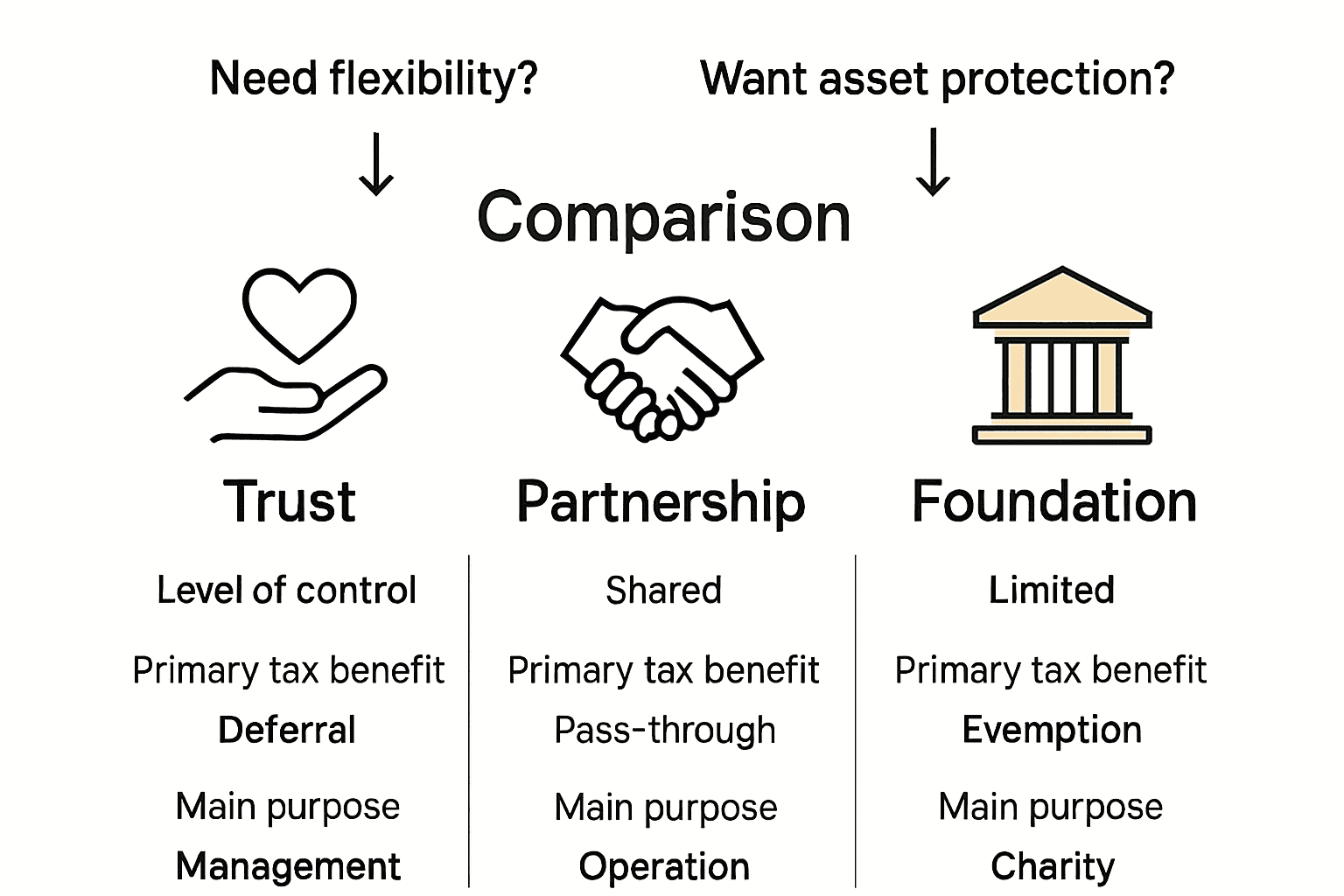Nearly $84 trillion is expected to change hands in the United States by 2045 as older generations pass their wealth to heirs. With so much at stake, families with significant assets must navigate a maze of legal, tax, and financial challenges to preserve what they have built. Effective wealth transfer planning goes far beyond inheritance, weaving together protection, tax efficiency, and lasting family legacies for the generations to come.
Key Takeaways
| Point | Details |
|---|---|
| Wealth Transfer Significance | Ultra-high-net-worth families face a significant wealth transfer, estimated at $84 trillion by 2045, necessitating strategic planning. |
| Holistic Approach Required | Successful wealth transfer requires integrating legal, tax, and emotional considerations to protect assets and family relationships. |
| Legal Structures and Strategies | Utilizing tailored legal frameworks like trusts and partnerships can optimize tax benefits and ensure efficient wealth transmission. |
| Risk Management and Compliance | Proactive risk management through clear documentation and professional advisement is essential for safeguarding family wealth across generations. |
Table of Contents
- Wealth Transfer Planning Explained
- Key Strategies and Transfer Methods
- Legal Structures and Regulatory Frameworks
- Taxation, Compliance, and Cross-Border Issues
- Common Pitfalls and Risk Management
Wealth Transfer Planning Explained
Wealth transfer planning represents a critical financial strategy for ultra-high-net-worth families seeking to preserve, protect, and strategically pass assets between generations. According to research tracking the “Great Wealth Transfer”, baby boomers and the silent generation are projected to pass down an extraordinary $84 trillion by 2045—making this one of the most significant intergenerational financial shifts in modern economic history.
At its core, wealth transfer planning goes beyond simply moving money from one generation to another. It involves strategic asset allocation, tax optimization, risk management, and creating comprehensive frameworks that protect family wealth while enabling smooth generational transitions. Successful wealth transfer requires careful consideration of multiple factors including:
- Legal structures like trusts and family limited partnerships
- Tax efficiency strategies
- Governance mechanisms for family wealth management
- Philanthropic planning
- Inheritance and estate tax considerations
The complexity of wealth transfer demands a holistic approach that balances financial mechanics with family dynamics. Wealthy families must navigate intricate legal, tax, and emotional landscapes to ensure their financial legacy supports future generations’ goals and aspirations. Professional guidance from wealth management experts, tax advisors, and legal specialists becomes crucial in developing robust transfer strategies that protect both financial assets and family relationships.
Key Strategies and Transfer Methods
Wealth transfer requires sophisticated strategies tailored to each family’s unique financial landscape. According to Asset Map, families have multiple sophisticated methods to efficiently transfer wealth while minimizing tax implications. These multigenerational planning approaches range from complex legal structures to strategic financial instruments designed to preserve and protect family assets.
Key transfer strategies include:
- Family Limited Partnerships: Allows controlled asset transfer while maintaining management oversight
- Charitable Lead Trusts: Provides tax-efficient philanthropic giving mechanisms
- Irrevocable Life Insurance Trusts: Creates tax-sheltered inheritance vehicles
- Intentionally Defective Grantor Trusts: Enables continued tax advantages during wealth transition
- Private Annuities: Facilitates structured intergenerational asset transfers
Research from SmartAsset highlights additional critical methods such as lifetime gifting with annual exclusions and strategic retirement account beneficiary designations. These approaches enable families to systematically distribute wealth while maintaining flexibility and minimizing potential tax burdens. Professional guidance becomes essential in navigating these complex transfer mechanisms, ensuring that each strategy aligns precisely with the family’s long-term financial objectives and preserves generational wealth integrity.
Legal Structures and Regulatory Frameworks
The legal architecture of wealth transfer is complex, requiring sophisticated structures that balance family objectives with regulatory compliance. Dynasty trusts emerge as a powerful mechanism for ultra-high-net-worth families seeking multi-generational wealth preservation. According to Wikipedia, these irrevocable structures are strategically designed to minimize estate, gift, and generation-skipping transfer taxes while simultaneously protecting assets from potential creditors.
Critical legal structures for wealth transfer include:
Here’s a comparison of key wealth transfer structures and their features:

| Structure | Asset Control | Tax Benefits | Primary Purpose |
|---|---|---|---|
| Revocable Living Trust | Grantor retains | Limited | Flexibility & probate avoidance |
| Irrevocable Trust | Irrevocable trustee | Strong Estate tax savings |
Asset protection & tax strategy |
| Family Limited Partnership | Family management | Discounted valuations | Coordinated family control |
| Charitable Foundation | Board/Trustees | Income & estate tax deductions | Philanthropy & legacy |
| Grantor Retained Annuity Trust | Grantor (initially) | Reduced gift/estate taxes | Asset transfer at low tax cost |
- Revocable Living Trusts: Provide flexibility during the grantor’s lifetime
- Irrevocable Trusts: Offer permanent asset protection and tax optimization
- Family Limited Partnerships: Enable controlled asset management
- Charitable Foundations: Support philanthropic goals with tax advantages
- Grantor Retained Annuity Trusts (GRATs): Transfer appreciating assets with reduced tax liability
Navigating these legal frameworks demands intricate understanding of tax regulations, inheritance laws, and strategic financial planning. Wealthy families must work closely with specialized legal professionals who can design customized structures aligned with their unique financial goals, risk tolerance, and intergenerational wealth transfer objectives. The ultimate aim is creating resilient legal mechanisms that protect family assets, minimize tax burdens, and provide sustainable financial continuity across generations.

Taxation, Compliance, and Cross-Border Issues
Wealth transfer in the global financial landscape demands sophisticated navigation of complex international tax regulations and compliance frameworks. Ultra-high-net-worth families must develop nuanced strategies that address the intricate challenges of cross-border wealth management, balancing legal obligations with strategic financial planning.
Key considerations for cross-border wealth transfer include:
- Tax Treaty Optimization: Understanding bilateral tax agreements
- Foreign Asset Reporting: Complying with international disclosure requirements
- Residency-Based Taxation: Managing tax implications of multi-country investments
- OffshoreStructuring: Legally minimizing tax exposure through international jurisdictions
- Regulatory Compliance: Adhering to global anti-money laundering and financial transparency regulations
The complexity of cross-border wealth transfer extends beyond simple tax planning. Families must develop comprehensive strategies that account for varying legal systems, potential geopolitical risks, and evolving international financial regulations. This requires a multidisciplinary approach, engaging specialized professionals including international tax attorneys, cross-border wealth management experts, and global compliance consultants. Successful wealth transfer in this context demands continuous adaptation, deep understanding of international financial ecosystems, and proactive management of potential regulatory challenges.
Common Pitfalls and Risk Management
Wealth transfer planning is fraught with potential risks that can derail even the most meticulously crafted strategies. According to Delaware Life, several critical common pitfalls can significantly compromise intergenerational wealth preservation, including fragmented planning documents, overlooked beneficiary designations, and inadequate communication between current asset holders and future inheritors.
Key risk management strategies involve:
- Comprehensive Documentation: Maintaining clear, updated, and synchronized planning documents
- Regular Beneficiary Reviews: Systematically checking account titling and designation updates
- Communication Protocols: Establishing transparent discussions with potential heirs
- Professional Advisory Team: Building a multidisciplinary support network
- Periodic Strategy Reassessment: Implementing routine reviews of wealth transfer plans
Successful risk management requires a proactive, holistic approach that transcends traditional financial planning. Wealthy families must cultivate a dynamic ecosystem of professional advisors, maintain rigorous documentation practices, and foster open intergenerational dialogue. The goal is creating resilient wealth transfer mechanisms that can adapt to changing personal circumstances, evolving tax regulations, and potential geopolitical shifts, ensuring the family’s financial legacy remains protected and strategically positioned for long-term sustainability.
Solve the Complexities of Wealth Transfer with Expert Support
Navigating wealth transfer planning can feel overwhelming. The article highlighted tough challenges like choosing the right legal structures, staying tax efficient, and avoiding costly mistakes that disrupt your family’s financial legacy. When multi-jurisdictional tax compliance or trust setup gets complicated, where do you turn for clarity and trusted advice?

Experience the power of a global network dedicated to your needs. At Future Family Office, you can connect with specialist professionals and explore exclusive resources that address every aspect of wealth transfer planning. Access up-to-date news, service provider directories, and valuable insights on family office strategies. Join today for a transparent community where your wealth management goals come first. The time to secure your family’s future is now. Visit Future Family Office to take your next step.
Frequently Asked Questions
What is wealth transfer planning?
Wealth transfer planning is a financial strategy designed for ultra-high-net-worth families to preserve, protect, and pass assets between generations while considering legal structures, tax efficiency, and family dynamics.
Why is wealth transfer planning important for families?
Wealth transfer planning is crucial for families to ensure a smooth transition of assets, minimize tax implications, and preserve family wealth, especially in light of significant intergenerational financial shifts.
What are some common methods used in wealth transfer planning?
Common methods include family limited partnerships, irrevocable life insurance trusts, and charitable lead trusts, all of which help in asset management and tax optimization during the transfer process.
How can families avoid pitfalls in wealth transfer planning?
Families can avoid pitfalls by maintaining comprehensive documentation, regularly reviewing beneficiary designations, communicating openly with potential heirs, and engaging a professional advisory team to reassess their strategies periodically.
Recommended
- Family Office Succession 2025: How Next-Gen Heirs Are Turning Wealth Into Impact – Future Family Office
- Family Office advisor extinction and how to avoid it – Future Family Office
- Bobby Gill on Family Offices: How to protect wealth for successive generations – Future Family Office
- Multigenerational Wealth Preservation: What You Need To Know – Future Family Office




